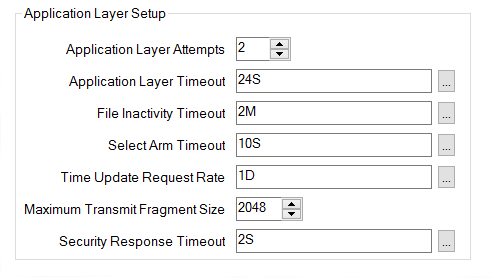Setup the Application Layer
The Application Layer is the highest user-configurable DNP3 communication level. Use the following fields within the Application Layer Setup section of the DNP3 Settings tab to specify the properties of the SCADAPack x70 device’s application layer:

Application Layer Attempts
Specify the number of times that the SCADAPack x70 device will send any Application Layer Fragments. Fragments are re-sent if an Application Layer Confirm for the fragment is not received within the Complete Fragment Timeout.
This field specifies the number of Attempts, not the number of Retries.
Application Layer Timeout
Specify the time (in seconds) within which the outstation requires a response to peer application layer requests. If no response is received within this time, the outstation re-sends the request fragment. This sequence is repeated until either a response is received, or the number of attempts equals the number specified in the Application Layer Attempts field.
Enter the required interval in the OPC Time Format. You can enter the value directly in the field, or use the Interval window (accessed via the field's browse button) to specify the required value.
File Inactivity Timeout
This allows you to specify (in seconds) the outstation file inactivity Application layer timeout. If a file transfer operation is in progress (for example, if a file is open) this is the maximum amount of time allowed between operations. If no file transfer operations occur in this period the file is closed and future file transfer operations on this file will fail. The timer restarts after each successful file transfer. The time specified needs to be sufficiently long enough for the expected upload / download file sizes and the speed of the communications link(s). The valid range is from 5 seconds to 3600 seconds. The default is 120 seconds.
Select Arm Timeout
Specify the time period (in seconds) within which the outstation has to receive an Operate command after receiving a Select command for a two-phase Select / Operate DNP3 Control. The valid range is 0 to 65 seconds. The default is 10 seconds.
If the Operate command that corresponds to the Select command is received before the timeout elapses, the outstation performs the control operation.
If the Operate command is not received within the specified time period, the control operation is rejected.
Enter the required interval in the OPC Time Format. You can enter the value directly in the field, or use the Interval window (accessed via the field's browse button) to specify the required value.
Time Update Request Rate
Specify how often the outstation requests a time update from its DNP3 Master (Geo SCADA Expert). The request is sent as a DNP3 IIN bit set in responses sent to the Master.
Enter the required interval in the OPC Time Format. You can enter the value directly in the field, or use the Interval window (accessed via the field's browse button) to specify the required value.
Maximum Transmit Fragment Size
A SCADAPack x70 device sends messages in fragments, which contain one or more frames. A frame is a variable-size data packet. Use this field to specify the maximum size of a fragment sent by the outstation. The fragment's size is determined by the SCADAPack x70 device's buffer. In environments with high levels of interference, reducing the fragment size may alleviate communications problems.
The size is determined by the receiving device’s buffer and the network type:
- Serial ports: 100 to 2048 bytes
- Ethernet ports: 254 to 2048 bytes
- USB ports: 1000 bytes
Messages that are larger than one fragment are sent using multiple fragments. Large fragments and multiple fragments are transmitted using more than one frame (for instance, a fragment of 2048 bytes needs breaking into at least 9 frames). Where this occurs, the frames are reassembled into the complete application fragment by the receiving device.
Security Reply Timeout
This allows you to specify (in milliseconds) the Secure Authentication reply time for outstation messages. The valid range is from 100 to 360,000 milliseconds and the default is 2000 milliseconds.